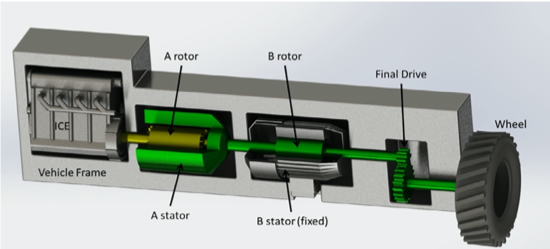Intelligent Power Systems
Annual PlanNovel Hybrid Electric Powertrains Enabled by Models of Electro-Magnetic-Structural Dynamics
Project Team
Principal Investigator
Bogdan Epureanu, University of Michigan Heath Hofmann, University of MichiganGovernment
Matthew Castanier, Denise Rizzo, U.S. Army GVSC
Industry
Xiao Guang Yang, Ford
Dean Tomazic, Kiran Govindswamy, FEV
Student
Chenyu Yi, University of Michigan
Project Summary
Project began 2017 and was completed in 2020.

This project supports research efforts of the Army including vehicle electrification, development of low noise auxiliary power units, and high performance lightweight Army technology objective. The TARDEC 30 year strategy identified a need for 45kW of electrical power while stationary in part to support advanced survivability and weapons systems. Advanced computational models of coupled electro-magnetic-structural (EMS) phenomena are critical for creating novel hybrid electric (HE) powertrains. These systems have stringent requirements on performance, durability, and reliability of their architectures.
This project provides modeling and simulation capabilities to address this need along with tools to enhance reliability by reducing torque fluctuations introduced with hybrid electric powertrains.
We developed a novel HE powertrain architecture and comprehensive models. The developed models enables 3D analyses and statistical studies of interest to OEMs, electric machine manufacturers, as well as other users of electric machines. For example, novel models of electromagnetic forces were constructed starting from the equivalent magnetizing current and/or the Maxwell stress tensor methods. Monte-Carlo simulations evaluated the effects of large and small variations in parameters of electric machines by varying the electromagnetic and mechanical fields and calculating the resulting dynamics.
The novel architecture developed is ideal for integration in autonomous modular systems where multiple power sources are merged into one complex powertrain. Performing the power split in such novel architectures is a challenging task, which can be addressed through the models developed.
Our main goal was to create and experimentally validate this model of a novel HE architecture, and construct novel models of electro-magnetic-structural (EMS) systems. Key objectives include:
- Create an advanced modeling framework for EMS systems based on reduced order models
- Develop a model of the novel HE powertrain architecture including coupled EMS models
Publications:
- Yi, C., Epureanu, B. I., Hong, S. K., Ge, T., & Yang, X. G.: Modeling, control, and performance of a novel architecture of hybrid electric powertrain system, Applied Energy, 178, 454-467, 2016
- Yi, C, Epureanu, B. I.: Control and Design Optimization of a Novel Hybrid Electric Powertrain System. Proceedings of the Dynamic Systems and Control Conference, 1-9, 2017
- Zeynu, M. A., Hofmann, H.: Design of Field-Oriented Control Based Brushless, Self-Excited Synchronous Field-Winding Machine with Combined Finite Element/Rectifier Model, IEEE Energy Conversion Conference and Expo, Cincinnati, Ohio, Oct. 1-5, 2017
- Yi, C., Hofmann, H., & Epureanu, B.I.: Energy Efficient Platooning of Connected Electrified Vehicles Enabled by a Novel Hybrid Electric Powertrain Architecture, Applied Energy, 2020, in review
- Yi, C., Hofmann, H., & Epureanu, B.I.: Design and Control Co-Optimization of a Novel Hybrid Electric Powertrain Architecture, IEEE Transactions on Transportation Electrification, 2020, in review
- Yi, C., Hofmann, H., & Epureanu, B.I.: Reduced-Order Models for Electro-Magnetic-Structural Coupling Phenomena, Mechanical Systems and Signal Processing, 2020, in review
#4.35

